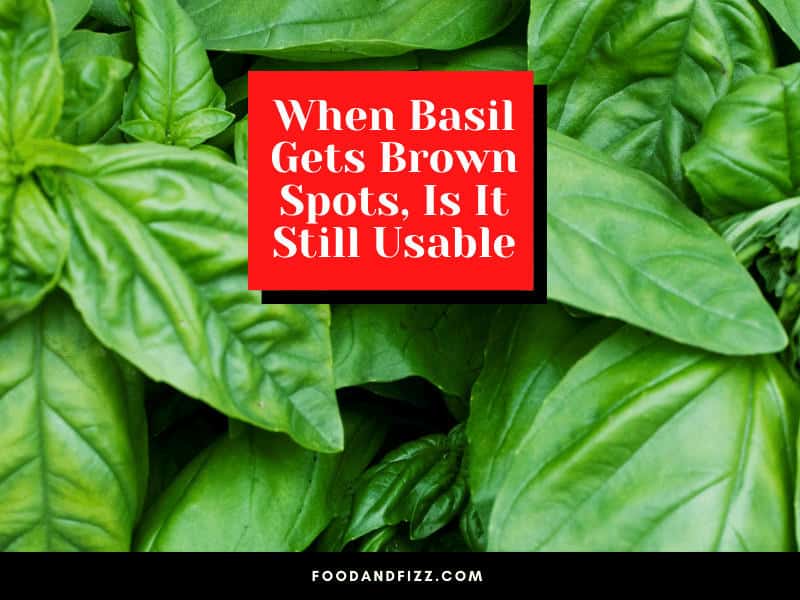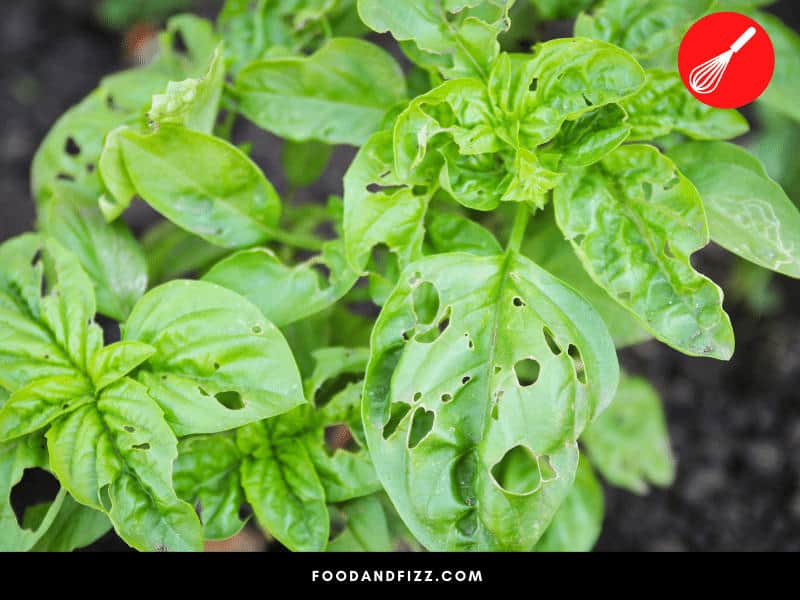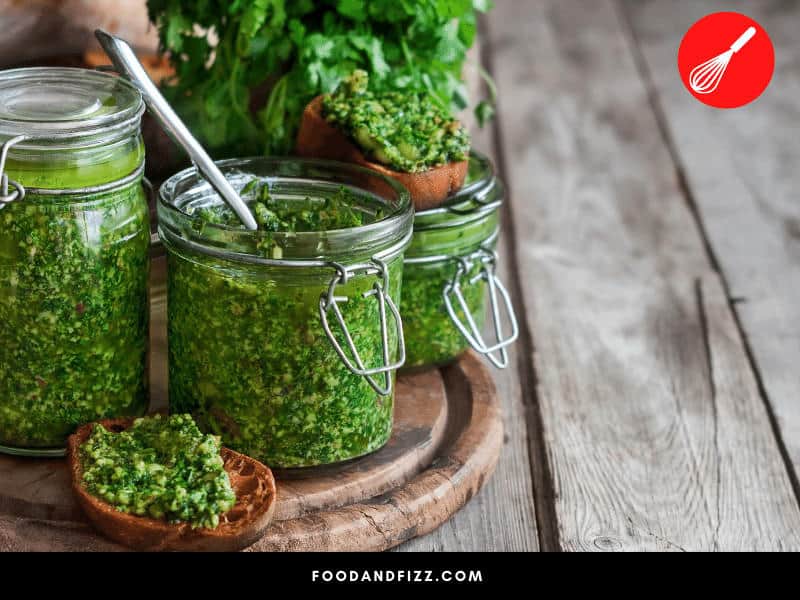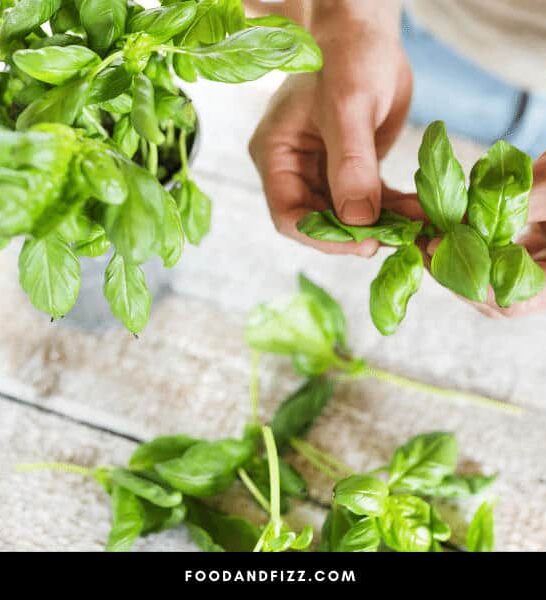Imagine this: you go to pick a few leaves of basil from your garden (or your patio garden), only to find brown spots.
Or perhaps you’ve bought a package of basil from the store, but by the time you start your recipe, the leaves have begun to brown.
What causes that browning? Is it still safe to eat basil leaves with brown spots?
When Basil Gets Brown Spots, Is It Still Usable?
Basil with brown spots may be ok to eat, but you probably shouldn’t do it. The spots may be caused by fungus, spores, mildew, or pests that can eat basil and leave behind eggs or feces. Don’t even compost those leaves—just toss them. Chances are, the brown leaves won’t taste as good anyway. If the plant is fighting off infection or pests, or the leaves in your refrigerator have begun to wilt, the sweet fragrant taste of basil is already diminished.

I Have Brown Spots On My Basil – What Should I Do?
In short, why not wait a few days till your plants heal, or spring for a fresh package of basil from the grocery store?
What Causes Brown Spots on Basil?
If you find brown spots on the basil spots in your garden, there are a few likely culprits. Let’s meet the usual suspects:
Fusarium Wilt
This fungus is a common cause of brown spots on basil, as well as other plants. It lives in the soil and can pass on from the leaves of infected plants, making it easy to spread and hard to eradicate.
The plants can seem fine at first and then develop brown streaks and wilted leaves. Even compost those leaves—throw them out to avoid re-infecting the soil.
Fungal Leaf Spot
Another common fungal infection that causes round brown spots on the leaves of basil and other garden greens. These spots disintegrate, leaving round holes.
This fungus loves a moist environment and can show up in your garden after a rain or in your refrigerator crisper if it gets damp.

Downy Mildew
Easily identifiable by the powdery gray fuzz that usually accompanies it, this infection appears when leaves get too wet.
Easy to avoid (it looks the most like mold!), the mildew leaves behind yellow or brown leaves. Keep your plants dry and well-spaced, and wrap your refrigerator basil in a dry paper towel when you get it home from the store.
Leaf Spot
Caused by several different conditions, leaf spot looks like brown or black blotches with lighter centers. Fungal infection from too much moisture is one cause of this problem. Prevent it by keeping leaves dry and watering from the side or below.
Another cause is too much nitrogen in the soil. Don’t bother fertilizing basil—it doesn’t need extra nitrogen!
How Can I Prevent Brown Spots on Basil?
If you’re looking to prevent brown spots on your garden basil plants, please make sure to do the following:
- Buy the best seeds or plants from a reputable source
- Plant your basil with enough space and sun for it to stay separate and dry
- Avoid overwatering, and don’t water from above directly onto leaves
- Act quickly to remove brown leaves and infected plants
- Don’t use pesticides or fungicides unless you’re certain they’re safe for human consumption

Growing your basil inside is a great way to avoid infections and pests altogether. Except for the ones that like to stroll past and steal a leaf now and then. Guilty!
When purchasing basil from the supermarket, if possible please choose fresh basil that is loose (rather than packaged in plastic).
Not only is it better for the environment to avoid plastic packaging, but the basil is less likely to have gotten cold, damp, or squished against itself—all factors that can encourage browning.
Put your grocery basil bunch into a cup of cold water (just the stems). Store it in your refrigerator door, or someplace it won’t tip over easily. This can avoid brown spots and extend the life of basil and other perishable herbs, even inside your fridge.
If your basil is turning brown during cooking, it’s because of oxidation: just like an apple, the leaves brown when their insides meet the air. Read on to find out how to address this and other common basil bothers.
My Basil Seemed Fine, But Now It’s Turning Brown on the Food—What Gives?
Like most green, basil wilts when it gets hot. That wilting is caused by oxidation. When the basil leaves are broken by heat, bruising, or cutting, they begin to oxidize.
To avoid or at least reduce this, add basil to your pan at the end of your cooking, and if you’re looking to garnish your plate with a few big, beautiful, green basil leaves, put them on the side, or wait till the food cools a bit.

How Can I Retain That Bright Green Basil Color When I Make Pesto or Cut Basil?
Basil can lose its emerald sheen when it gets crushed or blended. To keep the vibrant color, you can try these four strategies:
- Blanch the basil leaves in your pasta water. Just a quick dip will lock in the green by deactivating the enzyme that causes oxidation
- Put the basil leaves in a plastic Ziploc bag (or the eco-friendly equivalent), and roll or pound them with a rolling pin. Ironically, this bruising releases extra oils that add to the flavor and color of your sauce
- Add lemon juice. The citric acid in lemon juice is an antioxidant. A few teaspoons per cup of basil creates a pleasant acidity without being overwhelming.
- To cut basil without brown spots, mist the leaves with oil. The oil will coat your knife and seal the cuts, reducing bruising

Conclusion to When Basil Get Brown Spots, Is it Still Usable?
Basil with brown spots may be technically OK, but the risk of eating fungus, spores, mildew, or the traces of insect pests is not worth it.
Toss the wilted leaves, keep your basil dry, and try these techniques to prevent browning oxidation when the recipe involves heating, bruising, or cutting up basil leaves.
Frequently Asked Questions on When Basil Get Brown Spots, Is it Still Usable?
Is It Normal for Basil Leaves to Turn Brown When I Cook Them?
When basil is broken by heat, cutting or bruising, they oxidize and turn brown. To minimize this, you can add basil towards the end of cooking or wait till food cools down before adding.
How Can I Retain The Bright Green Color on Basil When I Make Pesto?
To minimize oxidation, you can either blanch the basil leaves, protect the leaves in a Ziploc bag before pounding or rolling, add lemon juice or mist the leaves with oil to minimize bruising.

